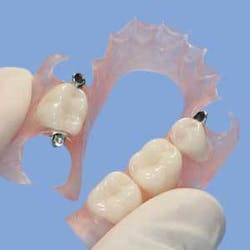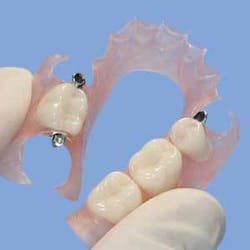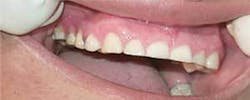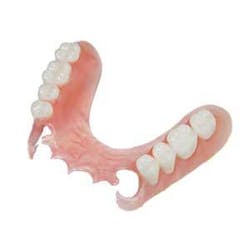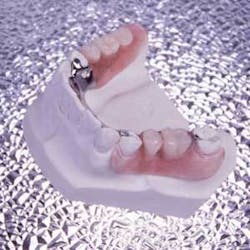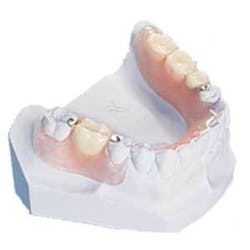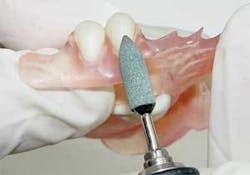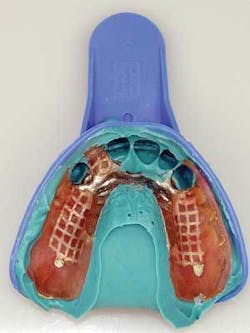Thermoplastics with metal rest seats
By Steven Rose, Orange County Cosmetic Dental Laboratory
Regarding the options available today for edentulous patients, we are seeing a virtual “esthetic revolution” because of recent technological advancements in the removable partial denture arena. Though implants are arguably the next best thing to original teeth as far as esthetics and performance, not all patients are good implant candidates, which is why options beyond implants are so valuable. Orange County Cosmetic Dental Lab has been at the forefront of this revolution by developing several new cosmetic partial denture designs. This “Tips from the Lab” will highlight features of the TCS Flexible thermoplastic material, and the partial denture design and benefits of a TCS Flexible thermoplastic partial with Vitallium rest seats compared to the TCS Flexible metal-free design. I will also review insertion and adjustment techniques and how to prepare for a reline and adding a tooth to the TCS Flexible thermoplastic partial.
TCS Flexible resin
The thermoplastic of preference is the TCS Flexible because of its strength, translucency, comfort, and esthetics. Another feature of TCS Flexible is the resin’s perfect degree of flexibility that will not warp or become brittle (figure 1). It is composed of durable thermoplastic nylon resin with a lifetime guarantee against breakage. The resin can also be relined and repaired. Because it is monomer-free, TCS Flexible is ideal for patients who are allergic to monomer, and it is also a perfect esthetic substitute for a metal partial, which exposes its unsightly metal clasps in a patient’s smile (figure 2). The TCS Flexible clasps blend genuinely into gum tissue, leaving a perfectly natural-looking smile (figure 3).
null
null
null
TCS Flexible with Vitallium rest seats
In my years of experience with partial denture materials and their esthetic qualities, thermoplastics have proven to be an excellent alternative. However, I have found that the functionality and comfort can be compromised with the metal-free designs (figure 4). With a removable partial denture, forces are applied and must be transferred to the supporting teeth and tissues in an atraumatic fashion. Metal-free thermoplastics lack metal cast rest seats, which transfer forces down the long axes of the abutment teeth. Not having these rest seats sometimes create discomfort and sore spots for patients. The problematic cases most experienced are in the mandibular arch. A metal-free thermoplastic on the mandibular arch tends to dig into the patient’s gum tissue, creating discomfort to the patient. It also tends to place excessive pressure and torque on the abutment tooth by the flexible clasp. The solution to this problem is a thermoplastic with either a metal framework or the metal cast rest seats design. The Thermoplastic with a metal framework works extremely well, especially in a mandibular Kennedy Class I arch. However, with this type of case, a lingual bar is required which may be cause for some hesitation with some patients because of the amount of metal involved (figure 5). In my opinion, the best option is the TCS thermoplastic partial with Vitallium rest seats (figure 6). What’s remarkable about this design is that it provides the proper support to the partial denture with minimal metal support and relieves excess pressure and torque on the abutment teeth, at the same time creating maximum comfort and superb esthetics.
null
null
null
Insertions techniques
After receiving and examining your finished thermoplastic partial, ensure that it was properly blocked out. There should be no space between the clasp and the tooth on the master model. Before placing the partial in the patient’s mouth, it is recommended to submerge the thermoplastic restoration in hot water for approximately 60 seconds. When the thermoplastic cools down to a tolerable temperature, gently insert it into the patient’s mouth. In case of clasp tightness, submerging that part in hot water for 30 seconds, removing it, and gently bending the clasp out while holding it underneath running cold tap water may loosen the clasp. Following the same procedure, but bending the clasp inward, can also tighten the clasp.
Adjustments
If the restoration needs reductions, it is recommended a green stone bur be used. Orange County Cosmetic Dental Lab provides a green stone bur with every thermoplastic case. I recommend using a handpiece at a low speed and then, with fast hand motions, lightly scrape the resin in forward and backward motions to reduce areas (figure 7). Make sure not to grind in one spot and keep the bur in motion because too much pressure may burn or distort the restoration. If fibers appear during grinding, they can be removed with a very sharp blade. After any major adjustments, it is advised to use pumice with a rag wheel over the grinded surfaces to prevent patient irritation.
null
Repairs and relines
Some dentists have a misconception that thermoplastics cannot be added to or relined. In reality, these are easy lab procedures, but can’t be done chairside. In order to add or replace a tooth to a thermoplastic partial, a pickup impression is necessary (figure 8). The laboratory will utilize either a welding technique for small repairs or an injection technique for larger repairs and retentive additions. In order to perform a reline on a thermoplastic, the laboratory will need a rubber base reline impression and a pickup impression over it. Thermoplastic relines with individual saddles can normally be relined using the injection repair technique, but in the case where an overall reline is indicated, the case is rebased.
null
Summary
With so many new options in materials and designs, it is so important to prescribe a restoration with excellent performance and accountability. TCS Flexible is a superb partial denture choice because of its strength and esthetics. Include Vitallium cast rest seats to a TCS Flexible to provide more stability and comfort along with uncompromised, elegant esthetics. For more information, call Orange County Cosmetic Dental Laboratory at (800) 696-7165
Steven Rose is a co-owner of O.C. Cosmetic Dental Laboratory. He began his laboratory career with the renowned Posca Family over a decade ago. Specializing in removable prosthetics, he has helped with the design of several innovative Partial designs such as the thermoplastic cast rest seat design and the Advantalock Partial. Lately, O.C. Cosmetic has been at the helm of innovation in removable prosthodontics. Rose may be reached via e-mail at [email protected].
